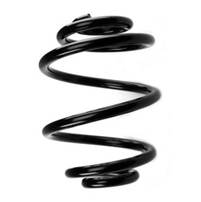Suspension

Coil Springs Technical AdviceAutomotive coil springs are one of the most central and dynamic components of a vehicle’s suspension system; constantly working to absorb shocks, keep the wheels in contact with the road and deal with uneven road surfaces. It is therefore no surprise that after many millions of cycles, even the best made springs will become tired and begin to sag; vehicle ride height will drop and may become uneven, and eventual breakage is likely. There are several reasons for spring failure, and Kilen take various steps to combat these to ensure the longest possible service life.
Poor quality spring wire – Surface and inner defects can exist in lower quality spring wire material. This reduces performance by lowering spring fatigue strength and significantly increasing the risk of breakage. Although almost all melting plants today can produce steel with the specified chemical analysis of ‘spring steel’, only a few mills are able to achieve the surface and wire quality necessary for modern suspension springs with high stress levels. The point to note here is that Kilen only use high grade, specialist ‘spring steel’ from selected mills worldwide. Heat treatment & Pre-setting – When springs are cold coiled, as many suspension springs are, negative internal stresses are introduced. These must be removed by heat treatment or the chance of failure (breakage) is increased significantly. Kilen remove these negative internal stresses through a controlled stress relieving heat treatment process after cold coiling. Following this, it is important to introduce and control the level of positive residual stress in the spring, as this will reduce shear stress during compression. The controlled use of shot peening and pre-setting ensure high positive residual stress levels within the spring and consequently a reduced risk of breakage during use. Tapered Wire Design – Some manufacturers use spring wire which tapers towards each end. This generally produces a weight saving, but the risk of premature spring failure is increased since the stress on the tapered wire is almost four times that of the parallel.
In general though, a linear rate is observed, since the reduced material diameter towards the end coils compensate for the reduction in the spring’s external diameter, meaning that spring rate generally stays consistent. It is also important to understand that springs made from parallel wire can equally be designed to have a linear or progressive spring rate. The danger with a tapered wire spring, however, is that stresses are almost the same throughout the total length of the material, meaning the end (or transition) coils can have stresses as high as those in the most active part of the mini-block, thereby leading to a greater probability of premature failure. While Kilen could offer both tapered and parallel wire springs, they choose only to produce from parallel spring wire (constant thickness), offering springs less prone to premature breakage, backed up by a 3 year warranty. Tapered wire spring designs, it should be noted, are also a modest and diminishing part of the market with, for example, the latest BMW E 90 rear spring now using a parallel wire design as opposed to its predecessor’s tapered design. Corrosion – Corrosion is the most common cause of spring failure, as defects and chips in the layer of lacquer cannot be avoided. Without additional protection, the spring steel will begin to rust immediately, leading to creep corrosion under the lacquer which spreads rapidly, significantly increasing the risk of breakage.
A corrosion attack at the transition end of the coils on a tapered wire spring carrying high stresses, will more quickly lead to breakage than parallel wire. Tapered wire is normally under high stress at the point where the spring leaves the spring plate support (the relief point), so increasing the risk of breakage when exposed to corrosion. Kilen provide an additional layer of corrosion protection between the paint and the spring by using the galvanic protection method of zinc phosphating on every spring. This provides protection from corrosion even after defects occur in the paint layer and is significantly more effective at preventing corrosion than other phosphating methods. Fitting in pairs When a spring fails, due to corrosion or other reasons, drivers often request that only the defective spring be replaced rather than replacing in axle pairs. Failure to replace in pairs can have multiple negative consequences, in addition to likely financial costs. Coil springs fitted in axle pairs degrade at around the same rate during normal use, meaning that when one sags or breaks, the other will most likely not be far behind. When just one spring is replaced on an axle, an imbalance can exist. Replacing springs in pairs will return the vehicle to the original ride height. Because coil springs are so vital to the overall handling of the vehicle, the uneven ride resulting from a failure to replace in pairs can cause multiple severe safety risks. These include: Less Responsive Steering – A sagging spring can cause a change in the camber angle on that wheel, resulting in less contact between the road and tyre, potentially causing the vehicle to pull in one direction. Additionally, the spring cannot effectively absorb and dissipate the vehicle load during cornering. This leads to increased body roll on bends. Less Secure Road Holding – A difference in ride height across one axle has a negative effect on the road holding properties of the vehicle, caused by uneven tyre contact with the road. Increased Braking Distance – An imbalance caused by a sagging or broken spring will reduce friction and road contact on one or more tyres, leading to an increase in the distance required to stop. Increased Tyre Wear – A change in the wheel angles caused by a defective spring can lead to faster tyre wear and a premature need for new tyres at a cost which could end up being more than that of a replacement coil spring.
According to the Vehicle and Operator Services Agency (VOSA), around 15% of all defects discovered during an MOT are suspension related and about 12% of vehicles fail the test due to a suspension problem. The VOSA MOT inspection guide gives the following reasons for failing a coil spring after visual inspection: – Cracked or fractured – Worn or corroded such that it is seriously weakened – Repaired by welding or damaged by excessive heat – Not correctly located – Coil spring mounting which is loose, cracked, fractured or seriously weakened by corrosion. It is therefore very important for workshops and garages to inspect springs at every opportunity and encourage customers to replace springs in pairs, just as they would with brake pads or discs. It is good practice for garages to advise the customer of any spring issues, even if they may not yet be at the point where MOT failure would be likely. Such issues may include: – Reduced ride height or vehicle imbalance – Excessive rust, particularly towards the ends of the coil – Salt, grit or water build-up within the spring mount, or deterioration of the mount itself – Chips or scratches to the spring’s surface or clear evidence of creep corrosion By replacing in pairs, the customer actually achieves an overall cost saving, since the labour to replace a pair will be cheaper than the labour for replacing individual springs twice within a short period of time. Not to mention the inconvenience of the vehicle being off the road on two occasions rather than the once. Kilen are firmly committed to providing the highest quality products. All Kilen springs come with a 3 year warranty and are certified OE ‘Matching Quality,’ allowing fitment without warranty restrictions and providing complete peace of mind. |
Related Articles Related Downloads |

 There are some misconceptions that progressive spring rate can only be achieved with tapered wire material, and that all tapered wire springs are progressive, especially in the case of mini-block (rugby ball shape) designs. However, springs (mini-block or otherwise) manufactured from tapered wire can have progressive or linear load and deflection characteristics (spring rate).
There are some misconceptions that progressive spring rate can only be achieved with tapered wire material, and that all tapered wire springs are progressive, especially in the case of mini-block (rugby ball shape) designs. However, springs (mini-block or otherwise) manufactured from tapered wire can have progressive or linear load and deflection characteristics (spring rate).
